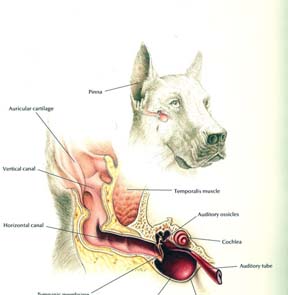Yeasty Ears
 HELP! MY dog has experienced repeated yeast infections in his ears. I treat them constantly, but the infection never goes away.
HELP! MY dog has experienced repeated yeast infections in his ears. I treat them constantly, but the infection never goes away.I am writing this as a veterinarian who treated such cases in my practice over the last 40 years. I am not a dermatologist but will gladly give my opinion based on my experience.
- You will need to commit yourself to treating this condition over the life of the dog. If you get it under control without requiring additional treatment, consider yourself very lucky.
Download Larger Picture
- Does the ear infection occur in one or both ears? Yeast infections generally occur in both ears and are systemic (involve the entire body) at the same time. If only one ear is infected, the recurring problem is usually the result of the ear canal being abnormally small. The only way to get this corrected is through a surgical procedure called a Modified Zepp. This procedure opens up the ear canal so air can get to it. Most ear infections would improve of their own accord if the ear canal could be kept dry. Checking for a narrow ear canal can be accomplished with a simple visual exam.
- There are numerous underlying factors that can interfere with treating a dog with a yeast infection. At the top of the list is an allergy. Next are hormone issues such as Hypothyroidism and Cushing’s Disease. A flea bite allergy falls under two categories: allergy and parasite. Pyoderma, which can be either a chronic or an acute bacterial skin infection, is another. There are more that I could add to this list of underlying causes, but these are some of the most important ones.
Many dogs start out with a chronic bacterial skin infection which is treated with antibiotics. The use of antibiotics causes the dog to be susceptible to the yeast infection. However, if a pyoderma (bacterial) infection is present, it needs to be addressed. Most skin infections are caused from Staphylococcus bacteria. It requires a specific antibiotic and treatment needs to be prescribed for at least six to eight weeks. In some cases, once the infection is under control, a lower maintenance dosage must be given to prevent the recurrence of the bacterial infection of the skin.
- The ear canal needs to be washed regularly. This needs to be done twice a week for the life of the dog. Daily cleaning can cause irritation to the cells lining the ear canal. Do not use a Q-tip to clean out the ear as it only pushes the debris deeper into the canal. The proper way of cleaning the ear canal is to fill it with an ear wash. Once you can see the fluid level, massage the canal below the opening. If done properly you will notice the fluid moving up and down in the ear canal. The debris will float to the top and can be wiped out with cotton balls.
The normal structure of the ear canal is such that it goes down below the ear canal opening an inch or two before it turns and goes inward.
- Commercial ear wash works best for cleaning as it breaks down grease, has drying agents, and aids in the destruction of the organism causing the ear issue by changing the environment, making it difficult for the organisms to grow. Constantly using antibiotics to treat the ear infection will only promote a resistance to the drugs used and allow organisms that are harder to treat to take over.
- Ketoconazole (systemic fungicide) is recommended in severe cases. It should be given daily for at least two months. Antifungal shampoos with benzoyl peroxide, miconazole, or ketoconazole are also helpful.
- Once the condition is under control, I would not stop the treatment. Over time you could gradually reduce the frequency of the therapy. However, stopping all treatment once the dog’s yeast infection appears to be under control will likely result in a recurrence within 60 days, resulting in beginning at square one again.
- A good home remedy that can be used to clean ears is equal parts vinegar and water mixed together. It breaks up grease and lowers the PH in the ear canal, making it more difficult for organisms to grow. It also does not cause a resistance to any drugs.
In conclusion here is a brief summary. Most dogs with a yeast infection also have some other issues going on at the same time. You need to rule out allergies and/or a pyoderma as one or both may be present. Initial treatment might need to address all three (yeast, allergy, and skin bacterial infection). A systemic drug such as ketoconazole is recommended along with topical shampoos and medication in the ear canal. The ear needs to be properly cleaned two to three times per week and once the condition is under control the cleaning needs to continue twice a week for the life of the dog. Antifungal shampoos should be used to treat the infection around the cartilage structures located on the inside of the ear proper near the ear canal opening. If the condition does not respond, further diagnostic tests are needed to rule out other ongoing issues.
Jim Sillers, DVM Michigan
Dr. Sillers writes for Sight & Scent Magazine, judges many breeds, especially hounds, and is a Master Gardener in his spare time.
